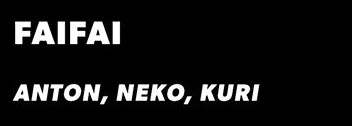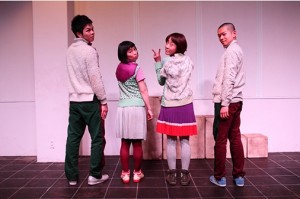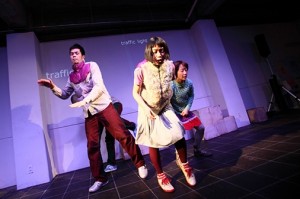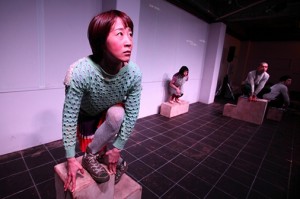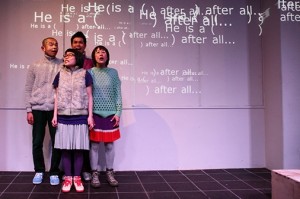EXPERIMENT SANS CONTROL GROUP
In 2012, Tokyo-based company Faifai decided to bring its 2009 movement-and-language assembly Anton, Neko, Kuri to international audiences. In a move she revealingly describes as “marketing,” director Chiharu Shinoda (with the help of stage designer Ayami Sasaki) imposed a huge projection screen dwarfing the four performers, upon which to project animated English-language supertitles as hard to look away from as video game graphics and not nearly as interesting to see. Ms. Shinoda reports that this intrusive addition is not intended as a permanent element of the piece when it’s performed in Japanese. So what you can see at the Roy and Edna Disney / CalArts Theatre (REDCAT) this weekend is not the Anton, Neko, Kuri audiences have supported in its home country, but a for-the-tourists version made for export. Let this fact settle for a moment. More than half of the visual element of this show was tacked onto an existing work, changing its emphasis and its very nature, to get you to come and see it; this, rather than presenting to you an of-a-piece whole.
Already in 2010 the evolving project had added the work of composer Yasuno Taro, who has turned the fractured language of the piece into music. REDCAT executive director Mark Murphy likens the results to a symphony. Ms. Shinoda prefers the term “polyphony.” I would offer “cacophony.” I would add that this show takes an hour to present, loudly and abruptly, some extremely mundane moments in the lives of some unremarkable folks. After fifteen minutes (that feel like thirty) of introduction to the show’s aesthetic, in which characters describe their environment by shouting out everything they can see, and act out a physicalized expressionist fantasy of everyday phenomena like cooking and brushing one’s teeth, a tenuous narrative is introduced involving a stray cat around whom an urban neighborhood vaguely interacts.
I found the performers’ Butoh- and Noh-inspired movements not compelling of themselves because they don’t transcend the smallness of their inspiration. The routine nature of the action I found stultifying rather than revelatory. If you don’t already know that life in a city can be lonely, and that you will have to interact with not particularly fascinating people and situations, this still might not be the piece for you because it says early what it has to say and keeps saying it at greater and greater volume with no accompanying explication of the experience.
The whole thing feels ad-hoc and without focus. The director has given her designers and dancer-actors a rough structure within which to do what they’re inspired to do; Kyoko Fujitani’s costumes, fragmented and stitched back together so that one actor wears half the sweater or trousers of another, suggest community and commonality, but the actors delineate character so specifically as to erase the gesture’s value. If the characters would stop yelling out “street,” “car,” “ceiling,” “paper bag,” maybe I could envision the actual meaning of the play.
Here’s the thing: if you need a narrative, invest in it. If you don’t, get rid of it and focus on the aesthetics. If your piece will travel, transport it. If it won’t, don’t complicate the thing with road-show bells and whistles: develop a piece that will travel intact.
photos by Kazuya Kato
Anton, Neko, Kuri
Faifai
REDCAT at Walt Disney Concert Hall
scheduled to end on November 24, 2013
for tickets, visit http://www.redcat.org/event/faifai
